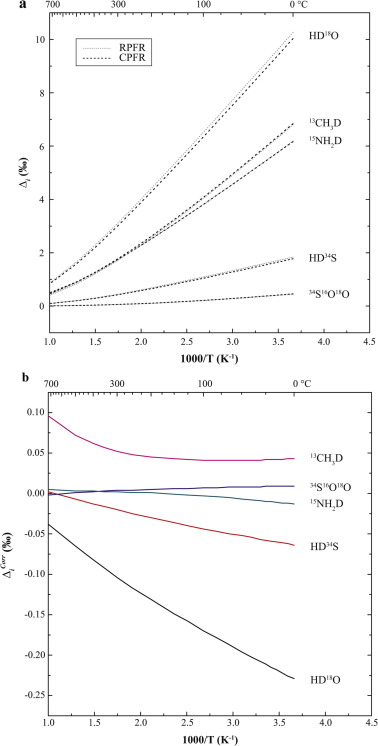High precision clumped-isotope signatures at equilibrium determined by theoretical methods are imperatively needed as references for the development of new clumped-isotope thermometers (or tracers). Recently, a study published in Geochimica et Cosmochimica Acta(2016, 175: 252-270) provides the clumped-isotope signatures at equilibrium of several gas-phase molecules obtained by using quantum chemistry methods with corrections beyond the harmonic approximation.
The authors, Associate Prof. LIU Qi and Prof. LIU Yun from the Institute of Geochemistry of the Chinese Academy of Sciences (IGCAS) have considered six corrections to the traditional Bigeleisen-Mayer equation to obtain the accurate clumped-isotope signatures at equilibrium and their temperature dependences.
In the study, clumped-isotope signatures are found to decrease with increasing temperature and show linear correlation with 1000/T, especially at temperatures < 500 K. The results suggest that the effects beyond the harmonic approximation contribute more for clumped-isotope systems containing deuterium substitutions, and play a less important role for calculating clumped-isotope signatures than for calculating isotope fractionation between different substances.
For the ongoing measurements of 13C-D clumping in methane, the scientists have carefully evaluated clumped-isotope signatures of 13CH3D, and found the abundance of 13CH3D at equilibrium to have ~ 6‰ enrichment at room temperature relative to the random distribution.
Furthermore, a practical approach of scaling clumped-isotope signatures has been proposed by the scientists, which can be used as a convenient way to improve the accuracy of these calculations.
Their method of calculating clumped-isotope signatures offers a theoretical framework to study the abundances of the doubly substituted isotopologues, and provides reference standards for the use of potential geothermometers and tracking kinetic processes. Obviously, the work shows up timely on the expanding of clumped-isotope geochemistry.
|
 |
|
Fig. Variation in equilibrated Δivalues and the contribution of higher-order corrections versus 1000/T, calculated at the MP2/aug-cc-pVTZ level. (a) RPFR, denoted by the dotted gray lines, indicates Δivalues calculated in the harmonic approximation. CPFR, denoted by the dashed black lines, are calculated using corrections beyond the harmonic approximation. (b) ΔiCorrare the differences between harmonic and anharmonic Δivalues, showing the net effect of higher-order corrections.(Image by IGCAS) |
Contact:
LIU Yun
Institute of Geochemistry, Chinese Academy of Sciences
E-mail: liuyun@vip.gyig.ac.cn
(By LIU Qi)